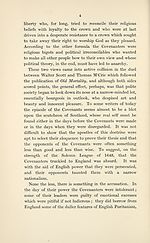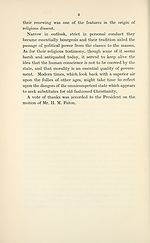Series 3 > Letters of James the Fourth, 1505-1513
(422) Page 5
Download files
Complete book:
Individual page:
Thumbnail gallery: Grid view | List view

5
and from the English Independents, too, they borrowed,
or at least some of them borrowed, the idea that the Lord’s
Prayer itself was suspect as a ‘ set form.’ On the other
hand, adherents to the Covenants might produce, as in
Colonel Blackadder, a bold soldier who could serve the
crown in arms, and the visitations of the University of
Glasgow in Covenanting times showed a regard for healthy
bodily exercise not evident in the recommendations of
other commissioners.
Plainly, all Covenanters and all periods are not to be
included in a single formula. The fundamental ideas were
the same but their expression varied, not only with per¬
sonality, but with circumstance. Analysing the psychology
of the Covenants, the speaker thought he detected three
distinct elements—the old Scottish idea of the ‘ band ’,
whereby the signatories ensured that all were equally
committed, the religious ‘ league,’ common in the sixteenth
century, which was a survival of the universalism of the
Middle Ages, and the Biblical Covenant in the sight of God,
which soon became a covenant of each of the subscribers
with God. It was from the third element that the Covenants
drew both their strength and their danger. From the days
of Knox on, some of the leaders of the Reformers spoke
and wrote as if they had peculiar access to the mind of
God. Hence, in the day of their power, the Covenanters
conceived it their duty to force their form of religious
belief upon other people ; in the day of adversity, however,
the Covenant became the palladium of resistance to
arbitrary power.
In the Latitudinarian days which followed the Revolu¬
tion of 1689 the Covenanters dissociated their resistance
from physical force but a pious remnant still regarded the
Covenants as a safeguard against popery and prelacy and
and from the English Independents, too, they borrowed,
or at least some of them borrowed, the idea that the Lord’s
Prayer itself was suspect as a ‘ set form.’ On the other
hand, adherents to the Covenants might produce, as in
Colonel Blackadder, a bold soldier who could serve the
crown in arms, and the visitations of the University of
Glasgow in Covenanting times showed a regard for healthy
bodily exercise not evident in the recommendations of
other commissioners.
Plainly, all Covenanters and all periods are not to be
included in a single formula. The fundamental ideas were
the same but their expression varied, not only with per¬
sonality, but with circumstance. Analysing the psychology
of the Covenants, the speaker thought he detected three
distinct elements—the old Scottish idea of the ‘ band ’,
whereby the signatories ensured that all were equally
committed, the religious ‘ league,’ common in the sixteenth
century, which was a survival of the universalism of the
Middle Ages, and the Biblical Covenant in the sight of God,
which soon became a covenant of each of the subscribers
with God. It was from the third element that the Covenants
drew both their strength and their danger. From the days
of Knox on, some of the leaders of the Reformers spoke
and wrote as if they had peculiar access to the mind of
God. Hence, in the day of their power, the Covenanters
conceived it their duty to force their form of religious
belief upon other people ; in the day of adversity, however,
the Covenant became the palladium of resistance to
arbitrary power.
In the Latitudinarian days which followed the Revolu¬
tion of 1689 the Covenanters dissociated their resistance
from physical force but a pious remnant still regarded the
Covenants as a safeguard against popery and prelacy and
Set display mode to:
![]() Universal Viewer |
Universal Viewer | ![]() Mirador |
Large image | Transcription
Mirador |
Large image | Transcription
Images and transcriptions on this page, including medium image downloads, may be used under the Creative Commons Attribution 4.0 International Licence unless otherwise stated. ![]()
| Scottish History Society volumes > Series 3 > Letters of James the Fourth, 1505-1513 > (422) Page 5 |
|---|
| Permanent URL | https://digital.nls.uk/126701655 |
|---|
| Attribution and copyright: |
|
|---|
| Description | Over 180 volumes, published by the Scottish History Society, containing original sources on Scotland's history and people. With a wide range of subjects, the books collectively cover all periods from the 12th to 20th centuries, and reflect changing trends in Scottish history. Sources are accompanied by scholarly interpretation, references and bibliographies. Volumes are usually published annually, and more digitised volumes will be added as they become available. |
|---|


